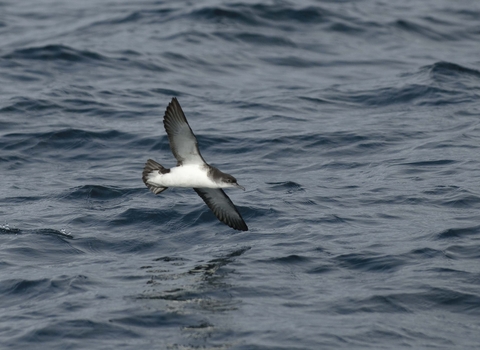
©Chris Gomersall/2020VISION
Manx shearwater
Scientific name
Puffinus puffinusWhen to see
February to JulySpecies information
About
Shearwaters are members of a group of birds known as ‘tubenoses’, the group also includes fulmars, giant albatrosses and tiny storm petrels. The incredible Manx shearwater flies for thousands of miles to return to the same burrow every year, nesting on small islands off the west coast of Britain. Raising only one extremely fluffy chick a year, the parents wait until the cover of darkness before heading out to fish. Shearwater chicks become so big that they are not able to leave the nest – and instead, must go on a crash diet in preparation for their big journey to South America for winter.How to identify
A medium-sized black and white bird, the Manx shearwater has long, stiff wings. About the size of a small gull, it is black above and white underneath.Distribution
Nests on rocky islands around the coasts of Wales, Scotland, Ireland and the Isles of Scilly.In our area
The enigmatic Manx shearwater is a symbol of conservation success on the islands. The Isles of Scilly are one of only two places in England where they breed, but at one point the Manx shearwater was on the brink of extinction on our islands. There were just a handful of breeding pairs remaining, and they were completely absent from the St Agnes and Gugh. Luckily, thanks to targeted conservation work from the Isles of Scilly Seabird Recovery Project, since 2015 the numbers of Manx shearwaters have been steadily increasing. In recent years, there have been over 80 breeding pairs recorded around the islands, a marked increase from just a decade ago.
Find out more about Manx shearwaters on the Isles of Scilly and their conservation.
Did you know?
A Manx shearwater that nested on Bardsey Island in Wales in 2008 was more than 50 years old and estimated to have flown about 5 million miles in its lifetime.The enigmatic Manx shearwater is a symbol of conservation success on the islands. The Isles of Scilly are one of only two places in England where they breed, but at one point the Manx shearwater was on the brink of extinction on our islands. There were just a handful of breeding pairs remaining, and they were completely absent from the St Agnes and Gugh. Luckily, thanks to targeted conservation work from the Isles of Scilly Seabird Recovery Project, since 2015 the numbers of Manx shearwaters have been steadily increasing. In recent years, there have been over 80 breeding pairs recorded around the islands, a marked increase from just a decade ago.
Find out more about Manx shearwaters on the Isles of Scilly and their conservation.
